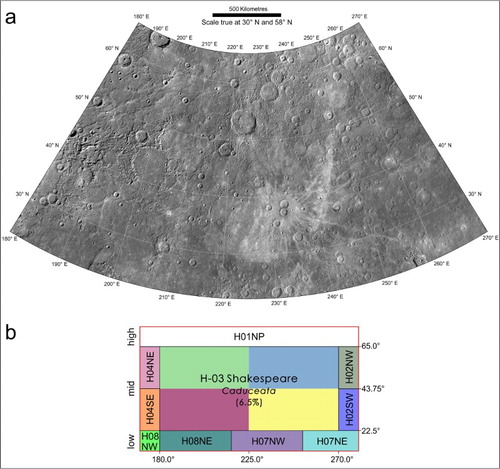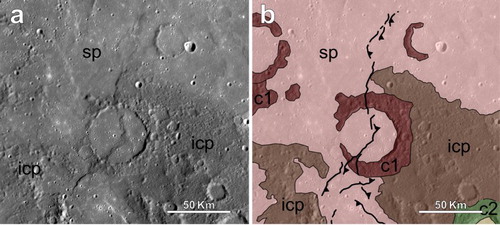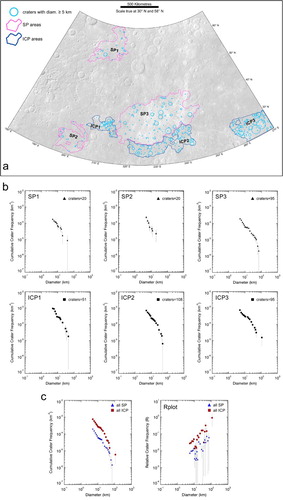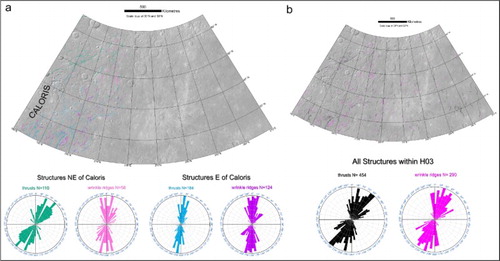Figures & data
Figure 1. (a) BDR basemap at ∼166 m/pixel resolution of the H03 quadrangle displayed in Lambert Conformal Conic (LCC) projection with standard parallels at 30°N and 58°N. (b) BDR tiles (displayed in Equirectangular projection) mosaicked to obtain the reference basemap with 5° overlap (red box) at its boundaries. The quadrangles are identified by their code (e.g. H-03, where H is the abbreviation for Hermes), their official name derives from topographic features (e.g. Shakespeare) and their former name (e.g. Caduceata) based on albedo features. The value (6.5%) represents the percentage of area covered by the quadrangle.

Figure 2. MLA topography available for the H03 quadrangle (CitationZuber et al., 2012). (a) MLA north pole coverage. (b) MLA global coverage.

Table 1. List of used basemaps.
Table 2. Types of mapped features (right column) and the class to which they belong (left column).
Figure 3. Type-localities for the three crater classes found within the H03 quadrangle. (a) ‘Ahmad Baba’ crater (232°E, 58°N) c3 class. (b) ‘Whitman’ crater (249°E, 41°N) c2 class. (c) Unknown crater (239°E, 47°N) c1 class.

Figure 4. (a) Thrust structures that crosscut a c1 crater (D ∼49 km; centred at 230°E, 29°N). (b) Thrusts were mapped as certain where the break in slope is clear and sharp and as uncertain where the break in slope is less clear and evident.

Figure 5. The range of plain morphologies within the H03 quadrangle. (a) Comparison of textures surface between SP and ICP in the central sector of the quadrangle, highlighted by clear albedo contrasts. (b) Example of SP with slightly corrugated surface texture with respect to the flatter shown in (a). (c) Example of ICP in the eastern sector of the quadrangle and IMP that occur as small patches.

Figure 6. (a) Low hills of the OF concentric to the rim of Caloris. In some places the boundary with the adjacent SP is gradational (approximate contact marked with dashed line indicated by arrows). (b) OF – knobby facies constituted by small blocks (yellow arrows), interpreted as Caloris ejecta, surrounded by smoothed material. The OF occurs between the ridges and grooves of the VEF.

Figure 7. (a) Six study areas (three for each unit) considered to determine the relative age of the SP and ICP units. (b) CSFDs for SP and ICP. (c) Comparison between the CSFD and the Relative-SFD (Rplot) diagrams of the two units.

Figure 8. (a) Distribution of the mapped structures surrounding the Caloris basin and relative azimuth-frequency diagrams showing the main trend for thrusts and wrinkle ridges, respectively. These structures have been gathered according to two preferential orientations: in the NE, NE–SW trending thrusts appear to form a radial pattern with respect to the Caloris basin geometry, whereas the wrinkle ridges are mainly oriented between N10°E and N15°E. To the East of the basin, the NNE–SSW oriented thrusts and wrinkle ridges appear to have a non-radial geometry with respect to Caloris. (b) Global distribution of all mapped structures in the H03 quadrangle and relative azimuth-frequency diagrams that show N40°–45°E and N15°–20°E azimuthal domains for thrusts and wrinkle ridges, respectively.

